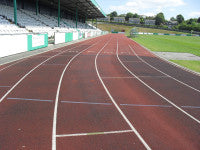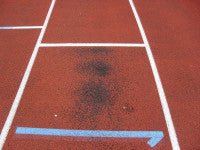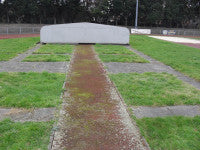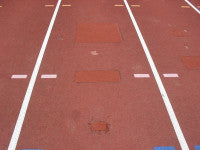Keeping your athletics track ready for the summer
 Did you know that there are more than 350 synthetic athletics tracks across the country which will face the harsh winter months alone and, in many cases, unloved?
Did you know that there are more than 350 synthetic athletics tracks across the country which will face the harsh winter months alone and, in many cases, unloved?
To ensure your track doesn't fall by the wayside this winter, maintenance experts, Technical Surfaces, and athletics track specialists, Polytan, talk us through the finer points of track construction, as well as the steps you can take to keep your athletics track ready for next season.
A full sized athletics facility is a massive capital commitment for any school, establishment, commercial organisation or association to make. Sadly however, once installed, the majority of tracks are left at the mercy of the elements, with little or no thought towards even the most basic maintenance plan.
To understand the type of maintenance your track may need, it is probably best to explain the types of surface currently in use.
Colour combinations aside, there are only two basic synthetic track systems; Porous and Non-Porous.
Porous
A porous system usually consists of two layers of synthetic material (the exception being the prefabricated 'roll out' system). The first layer is a 10-12mm black rubber crumb porous base, whilst the top 'wearing layer' is generally sprayed onto this, to a depth of 2-3mm, and can be various colours, but typically red.
The two layers bond together when laid in ideal conditions and so become one continuous surface. With this type of surface there is generally no need to have a drainage system, as water is dispersed through the entire track surface.
Non-Porous
There are three types of non-porous systems currently available:
Type one is sometimes termed a sandwich system. This, typically, has a base similar to that of the porous track, to which an intermediary 'sealing' layer is applied prior to the installation of the 'top wearing' layer. The sealing layer then enables the top layer to be installed without losing excessive material into the open base layer and maintaining an even level finish. The wearing layer has all the necessary texture required, but is ultimately non-porous, thus necessitating the installation of a drainage channel on either the inside or outside of the track to enable surface water to drain.
 Type two is the solid Polyurethane [PUR] system. This system is constructed using three layers of a poured polyurethane resin that has rubber granules cast into it to give it structure. The depth of the surface is generally 12-14mm. The top wearing layer of this surface has a similar appearance to the sandwich system. The PUR track is one of the most durable of all of the systems.
Type two is the solid Polyurethane [PUR] system. This system is constructed using three layers of a poured polyurethane resin that has rubber granules cast into it to give it structure. The depth of the surface is generally 12-14mm. The top wearing layer of this surface has a similar appearance to the sandwich system. The PUR track is one of the most durable of all of the systems.
Type three is a kit system, which consists of lengths of pre-fabricated track surface, usually one lane wide, which are glued down to the tarmac sub-base. Care must be taken with this system not to allow debris to collect in the many joints around the surface.
Surface Issues
Aside from the possibility of damage caused to the various surfaces by careless use of machinery, the majority of issues are caused by naturally occurring phenomenon. The most common issue for surfaces is the unwelcome growth of weeds, grass and moss to areas of the track that are neglected. During the life of the system, cracks may appear between the surface and the inner and outer kerbs, allowing dirt, seeds etc. to accumulate and thrive.
Once established, the root systems will eventually weaken and undermine the edges, causing cracks to develop and the edges of the track to collapse. To avoid this, care must be taken to regularly clean and spray, with weedkiller, all edges around the track perimeter. In a similar fashion, grasses will try to grow in and around landing pits of the jump run-ups. Again, regular cleaning and removal of early growth will ensure that sand is not left to accumulate against kerb edges, and helps to avoid future issues.
The track surface, being textured, will hold a little moisture and, in some locations, moss can be a particular problem if it is allowed to thrive. Regular treatment with a recognised moss inhibitor is recommended, at least quarterly if the location of your track makes it susceptible to moss growth.
Areas of track that are shadowed by trees require frequent cleaning to prevent the fallen leaves from both rotting on the surface, and either sealing porous tracks or creating slippery dangerous areas on the non-porous systems. If this material is left, it will blacken the track and the rotting leaves will encourage further growth of other plants.
These areas may also hold pools of water which - when it freezes in the winter period - open the surface of the track and cause it t o crack over time. Another issue with debris that is particularly relevant to non-porous tracks is, when it accumulates in the drainage channels, they will become blocked and prevent the track from draining effectively, causing issues with standing water and encouraging unwanted growth of plant life.
o crack over time. Another issue with debris that is particularly relevant to non-porous tracks is, when it accumulates in the drainage channels, they will become blocked and prevent the track from draining effectively, causing issues with standing water and encouraging unwanted growth of plant life.
Taking all of this into consideration, it is perhaps becoming clear that a little effort on a regular basis will eliminate many of the causes of long-term track degradation and, therefore, the need to spend much larger sums on rectification.
As a general rule, a full, professional deep clean of the track should be considered every three to four years, depending on a track's location and its frequency of use.
A number of smaller tasks should also be considered in order to fully prepare your track for winter, including:
1) Ensuring that only 'clean' sand is put back into the pits before covering them
2) Removing wooden take-off boards from runways and storing them inside
3) Wherever possible, removing landing mats and storing them in dry, secure storage areas - rabbits, rats and mice love them to overwinter in
4) Note any areas where water is pooling to remedy during the summer
5) Check drains are running clear, where possible clear/clean
6) Not leaving the last grass cuttings remaining on the track over winter to rot down
7) Ensuring that all covers are secured against potential winter winds and storms
8) Removing all equipment to storage areas - anything left on the track surface may well leave a shadow or rust mark when it is moved at the start of the new season (for example, hurdles and steeplechase barriers)
9) Where possible, draining the steeplechase water jump and insulating the feed pipes/valves with waterproof material
10) If the kerb is removable and is aluminium, then put it away (or risk losing it for scrap)
 Although not linked to the winter maintenance of your track, be mindful of the surface you have and, where budgets allow, do not mix surface types with DIY repairs, as this will cause issues in the long term, particularly if you repair a non-porous system with a porous repair. This allows water to penetrate the surface and could lead to further delamination and lifting of the surrounding track if the water freezes. What starts out as a cheap option could cost many times more to rectify if this happens.
Although not linked to the winter maintenance of your track, be mindful of the surface you have and, where budgets allow, do not mix surface types with DIY repairs, as this will cause issues in the long term, particularly if you repair a non-porous system with a porous repair. This allows water to penetrate the surface and could lead to further delamination and lifting of the surrounding track if the water freezes. What starts out as a cheap option could cost many times more to rectify if this happens.
Be aware of the heavy-wear areas of your track: start/finish lines, ends of throws and jump run-ups. If these areas are showing the classic signs of wear (i.e. the black base layer showing through), it is prudent to seek advice from a registered installer/repairer, as the base layer is much softer material and will degrade much quicker, causing potential hazards for athletes.
Try to encourage athletics clubs to vary the areas of training. Persuade them to avoid having 'favourite' lanes and starting positions. Spread the wear of your track wherever possible.
In summary, although athletics tracks may appear to require very little maintenance, it is important to recognise that they do need attention all year round, including the winter months when usage is reduced. A closed track costs money, time and inconvenience and can be easily avoided with a worthwhile maintenance programme.
www.technicalsurfaces.co.uk
info@technicalsurfaces.co.uk
Tel: 08702 400 700
